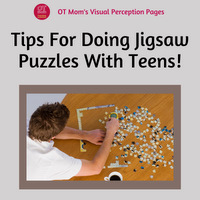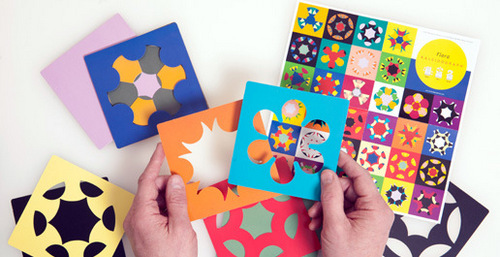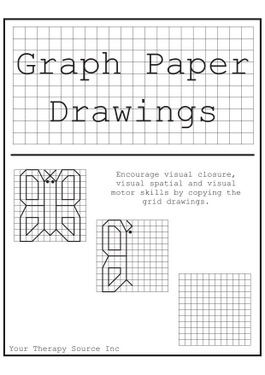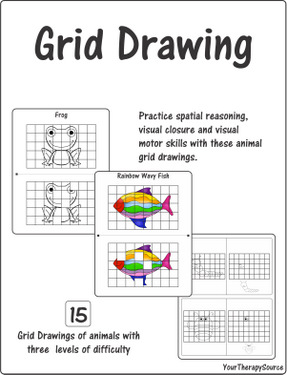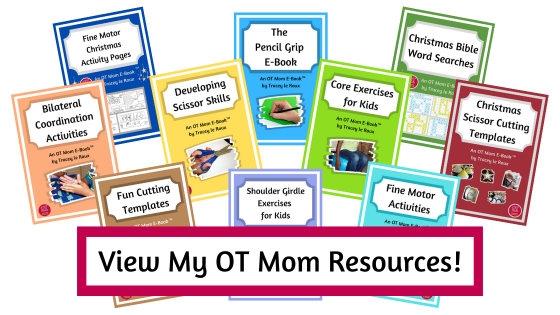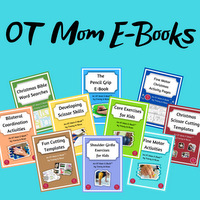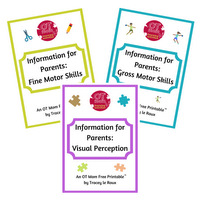- Home Page
- Visual Perception Activities
- Visual Perception Ideas For Older Kids
Visual Perception Activities
For Older Kids
Build Skills With Fun Ideas
Looking for visual perception activities for older kids that they will actually enjoy? It is often tricky to find activities that can build their skills without making them feel juvenile.
As my own kids have grown older, there are a bunch of visual perception games and activities that we have had lots of fun doing as a family, and I have used these same resources to help build the visual perceptual skills of older kids that I have worked with.
The best part is that they can easily be given as gifts, or added to the family game cupboard, without anyone feeling like they are being given a therapy activity!
So here are my favorites - with a brief explanation of how I use each one to encourage the development of visual perceptual skills, and any tips that might help.
I sometimes link to products (#Ad) that are similar to those I use and love. If you do purchase something through my links, I will receive a small commission that helps support my site - thank you!
Key Takeaways For Busy Parents:
- Visual processing games like Spot It! and Kaleidograph are fun for older kids while enhancing visual perception skills.
- "Seek-and-find" type books not only entertain but also develop figure-ground perception and visual scanning
- Learn strategies to slow down fast-paced games and adapt rules to suit your child’s pace and preferences.
- Visual perception games make excellent gifts for birthdays or holidays and can be seamlessly integrated into family game collections.
- Spot It! (Also called Dobble)
- Doing Jigsaw Puzzles
- Seek and Find Type Books
- Kaleidograph
- Visual motor printables for older students
This page contains affiliate links (#Ad) - I will earn a small commission if you purchase something through my links, which helps to support my free website. However, you are under no obligation to purchase anything!

Spot It! (Also Called Dobble in Europe)
Spot It! and Visual Perception Skills
This fast paced visual processing game is a huge hit with my own kids and their friends, even into the teen years. The best part is that it develops visual discrimination, visual scanning and figure-ground perception skills, while still being loads of fun!
Once the center card is visible, players have to quickly scan the center card and the card in their own hand to find an object which is common to both cards.
I personally also think it brings visual memory skills into play, because you learn to take a quick mental "photo" of one card to match up the items with the other card
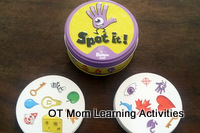 Spot It!
Spot It!Tips For Playing Spot It!
- I strongly recommend that you play the
game one-on-one with your child the first few times.
The reason for this is that the game, when played as designed, is very fast paced, and players have to be able to scan and identify very quickly. - One way of slowing it down is to only show the center card once your child has time to look at their card (rather than have the new center card be visible as soon as someone makes a match, as this is rather hectic, and your child may need more time to process)
- Another tip is to make sure your child knows the names of all the objects on the cards, so have your child practice naming all the objects on the cards as quickly as he/she can, to get the hang of the verbal demand. If your child struggles with the verbal aspect, change the rules a bit to enable them to grab the card when they see a match and then to point out the matching object to you for confirmation, instead of requiring a verbal call-out.
- It takes a bit of practice to learn how to visually scan each
card, and to develop the visual discrimination skills needed in order to
make the match. This takes time, so you as the parent can "go
slowly" to give your child time to see the cards without too much pressure. The "before you start" instructions in the game box can help with this.
- In addition, you may need to prompt your child to try and take a "mental photo" of the card. The pictures are colored exactly the same way, so the heart is always red, the web is always purple, so prompt your child to take a quick color scan to try and speed up the matching process.
View Spot It! On Amazon:
Doing Jigsaw Puzzles
Using Puzzles As Visual Perception Activities For Older Kids
Jigsaw puzzles can be fun, yet challenging activities for older kids and teens. Depending on the number of pieces, the size of the pieces and the picture itself, your teen will be boosting figure-ground perception, visual discrimination and spatial perception/orientation skills.
If your older child or teen has not really been interested in puzzles before, you may find it tricky to get started. I have put together a page of tips and strategies to help you spark your teen's interest in doing puzzles - check it out!
You can view some lovely 500 piece puzzles in the Ravensburger store on Amazon#Ad - these are the ideal size for older kids and teens, and there are all kinds of themes to catch your child's interest.
Cloudberry are a British company that make beautiful, funky puzzles that appeal to teens and young adults. I can vouch for the puzzle quality!
We have framed quite a few puzzles over the years to match our kids' bedroom decor!
"Seek And Find" Type Books
Visual perception skills in "Seek & Find" type books
If you are going on a road trip anytime soon, or if your child appreciates quiet down-time, these books make ideal visual activities for older kids. There are a number of seek-and-find type books that have been created for older kids, with "real" themes such as art, history and geography.
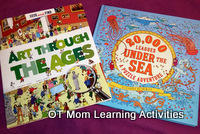 Lovely seek&find books
Lovely seek&find booksI love the fact that older kids can learn about art history, or famous landmarks, or classical literature, while having fun with these books.
And working on visual scanning and figure-ground perception into the bargain!
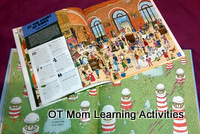
Tips for using "Seek & Find" type books
- Encourage your child to pay attention to detail, and show them how to systematically work through the page. You can show your child how to move a finger across the page and have the eyes follow the finger.
- Work from left to right, gradually moving down the page.
- You can also prompt your child to look in specific areas of the picture – "Have you looked in the house?", "How about the tree?
Here are some lovely "seek and find" type books on Amazon which can be used as great visual perception activities for older kids...
View "Seek and Find" type books on Amazon:
- Seek and Find - Around the World #Ad
- Seek and Find - Art Through The Ages #Ad
- 20 000 Leagues Under The Sea: A Puzzle Adventure #Ad
- Highlights' Hidden Pictures - Nature Theme #Ad
Kaleidograph
Kaleidograph and visual perception skills
Kaleidograph is a fantastic visual perception game for older kids. This was a regular go-to for my own older kids and teens when we are heading for a long car trip or a quiet weekend away.
Kaleidograph can be used for creative free play, where your child just plays around with the different layers and colors, or it can be used for focused copying of one of the designs given with the pack.
The focused design copying aspect is what will help develop visual perception, spatial perception and planning skills.
Your child will be using figure-ground perception and visual discrimination skills when they study the picture to discern the different elements of the design.
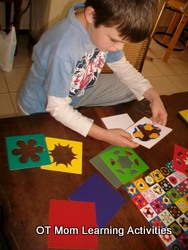 Fun with Kaleidograph
Fun with KaleidographTips for using Kaleidograph
I have a full review of Kaleidograph on my site, and on that page I have laid out various tips and strategies to help kids who struggle with any aspect of the activity.
So do pop on over and see photos of this game in action, as well as honest feedback about various aspects of the different sets.
The different sets make great visual perception activities for older kids and I highly recommend them.
- All the different Kaleidograph sets are available from Red Hen Toys (#ad) as well as specialty toy shops.
Visual-Motor Activities for Older Students
If you have an older student who needs to work on visual motor skills, then take a look at these printables created by Your Therapy Source.
Working with Graph Paper Drawings and Grid Drawings can help your child learn to visually focus and work on the lines. These visual motor workbooks are graded so you can start where your child is at, and increase the challenge as they improve.
Take a look and see if they will be a good fit for your child.
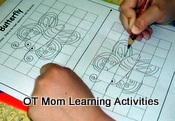 Visual Motor Worksheets
Visual Motor WorksheetsVisual perception activities for older kids don't need to feel like a chore for them. Whether they are drawn to the fast-paced game of Spot It!, the focus of a jigsaw puzzle, or the creative design of Kaleidograph, I hope you have found some tools to sharpen their skills in a fun way!
The next time you are looking for a family game or for a gift idea, consider one of these options. You will be creating fun memories while building skills!
My links to the products on Amazon were for your convenience - you may be able to find the products in your local department store, in a thrift shop or maybe even borrow them from a friend!
Thanks for visiting!
- Home Page
- Visual Perception Activities
- Visual Perception Ideas For Older Kids
Share this page to help others!
Didn't find what you were looking for? Try a search of my site!
